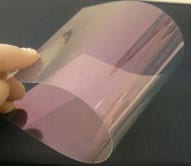 A new study gives insight into the ideal flexible plastic substrates for use when making organic electronic devices of all kinds. Thomas Brown and colleagues show each of the most commonly used polymer substrates gives the best performance in response to different stresses, and is therefore best suited to the fabrication of a particular type of device.
A new study gives insight into the ideal flexible plastic substrates for use when making organic electronic devices of all kinds. Thomas Brown and colleagues show each of the most commonly used polymer substrates gives the best performance in response to different stresses, and is therefore best suited to the fabrication of a particular type of device.
“The question on our mind was what conditions the substrates would ‘see’ and react to in the lab, during manufacturing and under every day operation in terms of their electrical, thermal, mechanical and optical properties,” explains Brown. “The variety of different substrate materials and tests ensure that the all results are directly comparable and thus immediately usable for gauging the suitability of each material for a particular purpose.”
The researchers studied polyethylene terephthalate (PET) and polyethylene naphthalate (PEN) polymers, two of the most commonly materials used as flexible transparent substrates for electronics applications. They compared them, both as native films and coated with indium tin oxide (ITO) for conduction, to metal foils and ITO-coated and fluorine tin oxide-coated glass.
By subjecting the materials to a range of tests, including thermal and solvent resistance, and mechanical deformation such as bending, and then studying the substrates’ optical and conductive properties, they were able to establish how each of the materials performed under stress.
Amongst their plethora of conclusions, in terms of resistance to thermal stresses, “we found that the limiting factor was not the electrical stability of the ITO coated films,” says Brown, “but the mechanical deformation of the plastic samples. No such deformation was appreciable for the metal foils.”
“Optical transmittance spectra showed that PET is more transparent than PEN, but application of an ITO coating reduced the absolute light transmittance in the visible by 5% for both films.” The researchers also found that UV-induced degradation was evident in the yellowing of PEN, but not noticeable in PET, giving direction to others looking to use materials in situations where they will be subjected to daylight.
“The results of our investigation reveal limitations and windows of opportunity of the various flexible substrates, which are applicable to the design of devices and the development of materials and processes, and also to the final application and its operation,” says Brown.
Of the future, he says the group hope to develop new methodologies or alternative processes that are compatible with, and exploit the best advantages of, these substrates to yield high-performance optoelectronic devices.

















